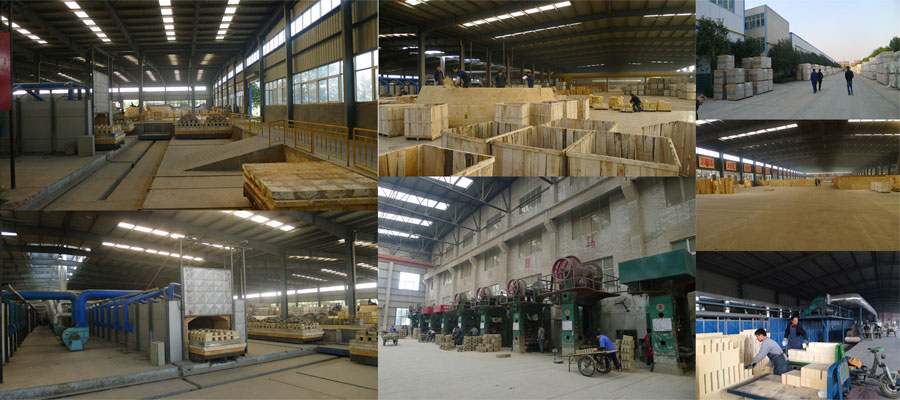Refractory materials are used in various fields of the national economy such as steel, non-ferrous metals, glass, cement, ceramics, petrochemicals, machinery, boilers, light industry, electric power, and military industry. They are essential materials to ensure the production and operation of the above industries and technological development. It plays an irreplaceable important role in the development of high temperature industrial production.
There are many kinds of refractory materials and different uses. It is necessary to scientifically classify refractory materials in order to facilitate scientific research, rational selection and management.
Acidic refractory materials are mainly composed of silica, and commonly used are silica bricks and clay bricks. Silica brick is a siliceous product containing more than 94% of silicon oxide. The raw materials used are silica, waste silica brick, etc. It has strong resistance to acid slag erosion, high softening temperature under load, and does not shrink in volume after repeated calcination, and even slightly expands; However, it is easily corroded by alkaline slag and has poor thermal shock resistance. Silica bricks are mainly used in thermal equipment such as coke ovens, glass melting furnaces, and acid steelmaking furnaces. Clay bricks use refractory clay as the main raw material and contain 30% to 46% alumina. They are weakly acidic refractory materials with good thermal shock resistance and corrosion resistance to acidic slag.
Neutral refractory materials are mainly composed of alumina, chromium oxide or carbon. Corundum products containing more than 95% alumina are high-quality refractory materials with a wide range of uses. Chrome bricks with chromium oxide as the main component have good corrosion resistance to steel slag, but poor thermal shock resistance and low deformation temperature under high temperature load. Carbonaceous refractory materials include carbon bricks, graphite products and silicon carbide products, which have low thermal expansion coefficient, high thermal conductivity, good thermal shock resistance, high temperature strength, and resistance to acid, alkali and salt erosion, especially weak acid and alkali. Good resistance, not wetted by metal and slag, light weight. It is widely used as high-temperature furnace lining material, and also used as autoclave lining for petroleum and chemical industry.
Alkaline refractories are mainly composed of magnesia and calcium oxide, and magnesia bricks are commonly used. Magnesia bricks containing more than 80% to 85% of magnesium oxide have good resistance to alkaline slag and iron slag, and their refractoriness is higher than that of clay bricks and silica bricks. Mainly used in open hearth furnace, oxygen blowing converter, electric furnace, non-ferrous metal smelting equipment and some high temperature equipment.
Refractory materials used in special occasions include high-temperature oxide materials, such as alumina, lanthanum oxide, beryllium oxide, calcium oxide, zirconia, etc., refractory compound materials, such as carbide, nitride, boride, silicide and sulfide etc.; high-temperature composite materials, mainly including cermets, high-temperature inorganic coatings and fiber-reinforced ceramics.
Frequently used refractories include AZS bricks, corundum bricks, direct bonded magnesia-chrome bricks, silicon carbide bricks, silicon nitride bonded silicon carbide bricks, nitrides, silicides, sulfides, borides, carbides and other non-oxide refractory materials. ; Calcium oxide, chromium oxide, aluminum oxide, magnesium oxide, beryllium oxide and other refractory materials.
Commonly used thermal insulation refractory materials include diatomite products, asbestos products, and thermal insulation boards.
Unshaped refractories that are often used include furnace repair materials, ramming materials, castables, plastics, refractory clay, refractory gunning materials, refractory projection materials, refractory coatings, lightweight refractory castables, gun mud, etc.
Bulk refractory material (unshaped refractory material): Unshaped refractory material is a refractory material that is composed of reasonably graded granular and powdery materials and binders without molding and firing. Usually, the granular material that constitutes this material is called aggregate, the powdery material is called admixture, and the binder is called cement. This kind of material has no fixed shape and can be made into slurry, mud paste and loose, so it is also known as bulk refractories. This kind of refractory material can be used to form a seamless integral structure, so it is also called integral refractory material.
The basic composition of unshaped refractory materials is granular and powdery refractory materials. According to its use requirements, it can be made of various materials. In order to combine these refractory materials into a whole, except for a few special cases, an appropriate type and quantity of binders are generally added. In order to improve its plasticity or reduce water consumption, a small amount of appropriate plasticizer and water reducer can be added. In order to meet other special requirements, a small amount of appropriate other admixtures can also be added.



